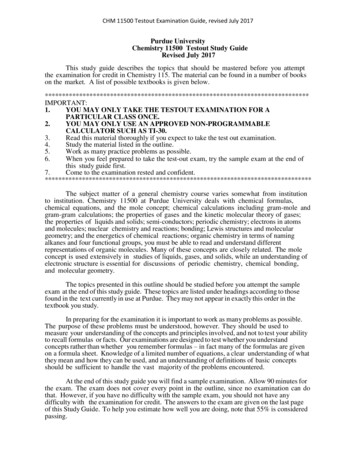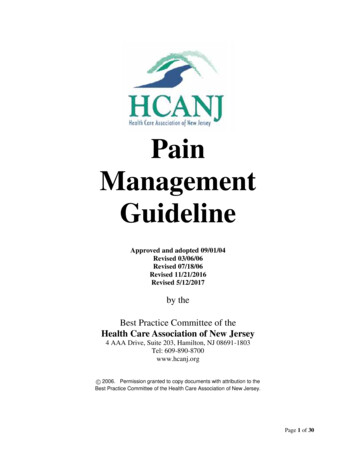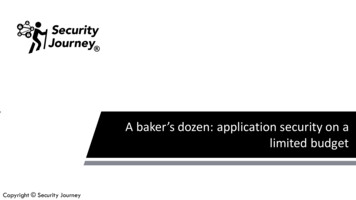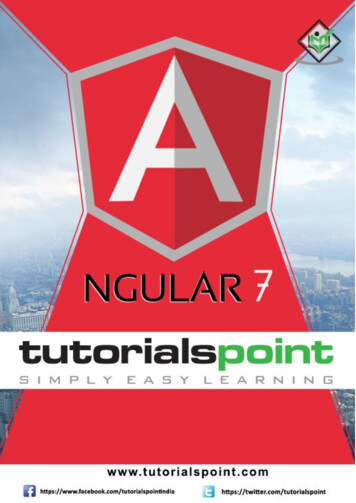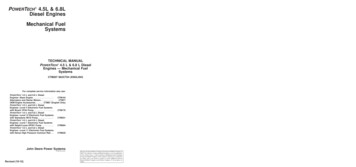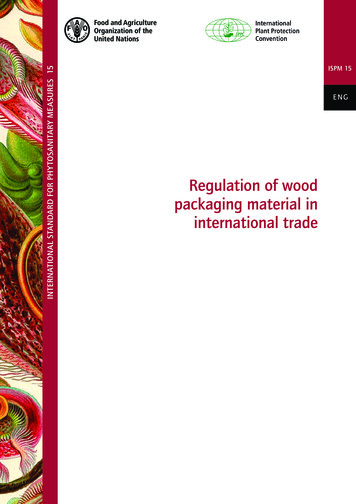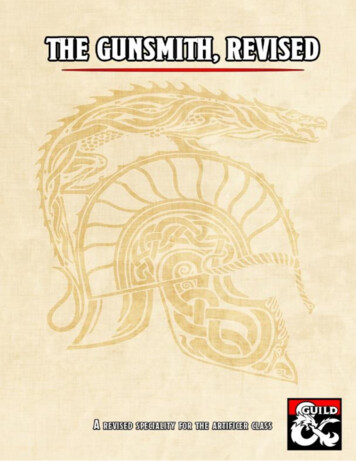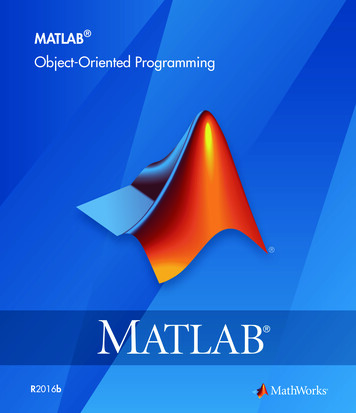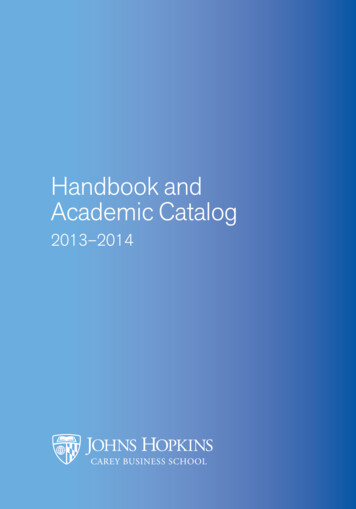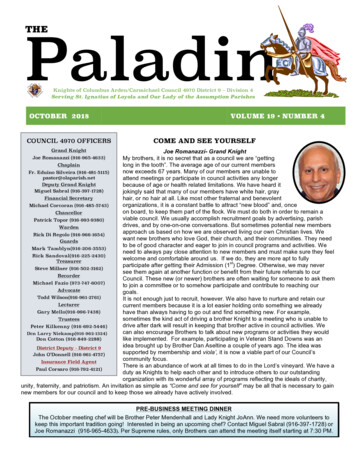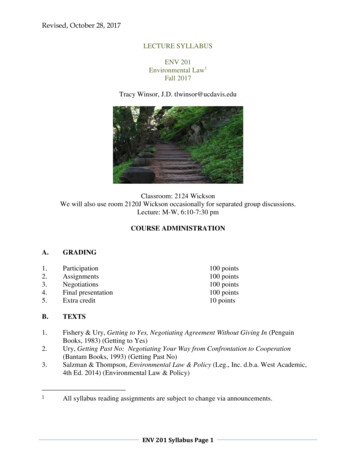
Transcription
Revised, October 28, 2017LECTURE SYLLABUSENV 201Environmental Law1Fall 2017Tracy Winsor, J.D. tlwinsor@ucdavis.eduClassroom: 2124 WicksonWe will also use room 2120J Wickson occasionally for separated group discussions.Lecture: M-W, 6:10-7:30 pmCOURSE gnmentsNegotiationsFinal presentationExtra creditB.TEXTS1.Fishery & Ury, Getting to Yes, Negotiating Agreement Without Giving In (PenguinBooks, 1983) (Getting to Yes)Ury, Getting Past No: Negotiating Your Way from Confrontation to Cooperation(Bantam Books, 1993) (Getting Past No)Salzman & Thompson, Environmental Law & Policy (Leg., Inc. d.b.a. West Academic,4th Ed. 2014) (Environmental Law & Policy)2.3.1100 points100 points100 points100 points10 pointsAll syllabus reading assignments are subject to change via announcements.ENV 201 Syllabus Page 1
Revised, October 28, 2017C.ADMINISTRATIVE ANNOUNCEMENTS1. It’s important to buy correct edition of the Environmental Law & Policy text (4thEdition). Do not buy a different edition, because the pages won’t line up with the readingassignments.2. All assignments listed below should be read or completed before the date of the lectureor discussion. As an example, the first reading assignment listed below should becompleted on or before September 27, 2017, in advance of the first day of class/firstlecture.3. For each lecture and negotiation, there are pages with the name of the lecture ornegotiation on it on Canvas. Any reading materials you are asked to read or view onCanvas for that lecture or negotiation will be linked to the relevant page.4. There may be links to PowerPoint slides on Canvas. Lecture PowerPoints may beupdated just prior to class, so if you plan to take notes on the margin during lecture, it’sbest to wait to download them until the day of that lecture.ENV 201 Syllabus Page 2
Revised, October 28, 2017Week of 9/259/27 INTRODUCTION TO ENVIRONMENTAL LAW; SOURCES OF THE LAWRead or watch, as appropriate, prior to lecture In Environmental Law & Policy, pp. 17-31, 51-61 (top). On Canvas:o A Brief Overview of the Supreme Courto Inside the California Supreme Courto What is the common law?o Jury instructions for negligence, nuisance, trespass, strict liabilityo Leslie Salt Co. v. San Francisco Bay Conservation and Development Comm.(1984) 153 Cal. App. 3d 605Class: Lecture & Q&A.Week of 10/210/2 THE LITIGATION PROCESS; ALTERNATIVE DISPUTE RESOLUTIONRead: Getting to Yes, pp. 3-5710/4 ENVIRONMENTAL REGULATION, ENVIRONMENTAL ENFORCEMENTRead: Environmental Law & Policy, pp. 65-74, 87-106 On Canvas:o Gwaltney of Smithfield Ltd v. Chesapeake Bay Foundation (1987) 484 U.S. 49o People v. Roscoe (2008) 169 Cal.App.4th 829Class: Lecture & Q&A.Week of 10/9Lecture 10/9 AIR QUALITY; WILDLAND FIRE LAWS (BEGIN)Read: In Environmental Law & Policy, read: pp 111-131 (skip exercise) and 132-137 On Canvas:o Health & Safety Code Sections 13007-13010o Skim, on Canvas (only so much as interests you): Climate Change, Wildland Fires, Forest Management – Articles, ResearchPapers You may wish to visit the air quality closed library to get a feel for thematerials that are in it at this time.ENV 201 Syllabus Page 3
Revised, October 28, 2017Class: Lecture & Q&A.Week of 10/16Lecture 10/16 WILDLAND FIRE LAWS (WRAP-UP)On Canvas, read: Health & Safety Code sections 13007-13010 Kelly v. CB&I Constructors, Inc. (2009) 179 Cal.App.4th 442 Gould v. Madonna (1970) 5 Cal.App.3d 404 United States of America v. CB&I Constructors, Inc. (9th Cir. 2012) 685 F.3d 827 State of California v. Southern Pacific (1982) 133 Cal.App.3d 862Class: Lecture & Q&A.10/18 AIR QUALITY CASE STUDY: IDENTIFYING THE PROBLEM AND SOLUTIONRead: Getting to Yes, pp. 58-83 On Canvas, Air Quality Negotiation Page, read or review:o Materials in closed library;o Mutual Fact Pattern.Assignment: Review materials on Air Quality Negotiation page. This is your “closed library”for this negotiation. Locate one or more additional resource(s) that are relevant to the issuespresented by the negotiation fact pattern. Upload a copy of or link to your proposed additionalresource with a paragraph summary of why you believe it is relevant and useful to thenegotiations to Canvas at or before 6:10 p.m. on 10/18. Bring a copy of your resource to class(electronic or paper). Be prepared to discuss why this additional resource should be added to thelibrary of materials for reference in the negotiation.Class: Students will explain what the materials they want to add to the negotiation library areand how they are relevant to the negotiations. Instructor will decide what materials will beadded. We will then use any remaining time for each group to (1) identify; and (2) present to theclass, the legal issues they believe are presented by the problem.ENV 201 Syllabus Page 4
Revised, October 28, 2017Week of 10/2310/23 AIR QUALITY NEGOTIATION: ROUND 1Read: Getting to Yes, pp. 101-149 Confidential round 1 facts for your group (these will be emailed to each group byinstructor). On Canvas, Air Quality Page, review materials in closed library.Assignment:Meet with your group to(1) Prepare your strategy for the negotiation round 1. Select three individuals from yourgroup to advocate for your group’s position in class. Each team member should uploadto Canvas, at or before 6:10 p.m. on 10/23, an outline of a proposed negotiationstrategy.2(2) Assign people from your group to prepare any exhibits for your negotiations (exhibits arepermissible only to demonstrate matters identified by the fact pattern or the closedlibrary). Select two individuals from your group to advocate for your group’s position inclass.Class: In class, there will be one hour of negotiation by the two individuals nominated by eachteam to represent their group and advocate for its position, then the remaining class time will beused for discussion and feedback on the negotiation.10/25 AIR QUALITY NEGOTIATION: ROUND 2Read: Round 2 confidential facts for your group (these will be emailed to each group byinstructor). On Canvas, Air Quality Page, review materials in closed libraryAssignment: meet with your group to prepare your strategy for the negotiation round 2. Selectthree different individuals from your group to advocate for your group’s position in class.Assign individuals to prepare any exhibits for the negotiation round 2 (exhibits are permissibleonly to demonstrate matters identified by the fact pattern or the closed library). Each teammember should upload to Canvas at or before 6:10 p.m. on 10/25 an outline of a proposednegotiation strategy.2For each assignment where a negotiation strategy must be uploaded, the negotiation strategyuploaded by each team member should include the strategy selected by the team and may alsoinclude additional information if there was disagreement on the approach. If additionalinformation is included, explain why you would have approached the negotiation that way, ratherthan what the team selected.ENV 201 Syllabus Page 5
Revised, October 28, 2017Class: In class, there will be one hour of negotiation by two individuals nominated by each teamto represent their group and advocate for its position, then the remaining class time will be usedfor discussion and feedback on the negotiation.Week of 10/3010/30 WILDLAND FIRE NEGOTIATION: IDENTIFYING THE PROBLEM ANDSOLUTIONOn Canvas, Wildland Fire Negotiation Page, read or review: Materials in closed library. Confidential facts (emailed to each team) Mutual Fact Pattern.Assignment: Review materials on Wildland Fire Negotiation page. This is your “closed library”for this negotiation. Also review confidential facts emailed to you. Locate one or moreadditional resource(s) that are relevant to the issues presented by the negotiation fact pattern.Upload a copy of or link to your proposed additional resource with a paragraph summary of whyyou believe it is relevant and useful to the negotiations to canvas at or before 6:10 p.m. on10/30. Bring a copy of your resource to class (electronic or paper). Be prepared to discuss withyour group why this additional resource should be added to the library of materials for referencein the negotiation.Class: Finish up wildland fire lecture material. We will then break into groups with your teams.Teams will discuss, with instructor, negotiation library and materials added to library as well aswhy the materials are relevant to the facts and legal issues. We will then use any remaining timefor each group to begin to develop its proposed strategy for negotiation of this problem.Instructor will take questions regarding the materials in the closed library, the teams’ proposedstrategies, and the law governing wildland fire liability.11/1 WILDLAND FIRE NEGOTIATION: IDENTIFYING THE PROBLEM ANDSOLUTIONRead: Getting Past No, pp. 3-14, 17-28, 159-171 Confidential facts for Wildland Fire Negotiation (emailed to each group by instructor) On Canvas,o Wildland Fire Negotiation Page, review material in closed library and mutualfacts.Assignment:Meet with your group to:(1) further prepare your strategy for the negotiation rounds 1 & 2. Select three individualsfrom your group to advocate for your group’s position in class as to each round.ENV 201 Syllabus Page 6
Revised, October 28, 2017(2) Assign people from your group to prepare any exhibits for your negotiations (exhibits arepermissible only to demonstrate matters identified by the fact pattern or the closedlibrary). Select two individuals from your group to advocate for your group’s position inclass.Class: Finish up wildland fire lecture material. We will then break into groups with your teams.Teams will discuss, with instructor, negotiation library and materials added to library as well aswhy the materials are relevant to the facts and legal issues. Instructor will take questionsregarding the materials in the closed library, the teams’ proposed strategies, and the lawgoverning wildland fire liability. Each group will begin to develop its proposed strategy fornegotiation of this problem.Week of 11/611/6 WILDLAND FIRE NEGOTIATION ROUND 1Read: Getting Past No, pp. 76-104 Review confidential facts for Wildland Fire Negotiation On Wildland Fire Negotiation Page, review material in closed library.Assignment: meet with your group to further refine your strategy for the negotiation rounds 1 &2. Each team member should upload to Canvas, at or before 6:10 p.m. on 11/6, an outline ofyour negotiation strategy for round 1.Class: In class, there will be one hour of negotiation by the three individuals nominated by eachteam to represent their group and advocate for its position, then the remaining class time will beused for discussion and feedback on the negotiation.11/8 WILDLAND FIRE NEGOTIATION ROUND 2Read: Getting Past No, pp. 129 (middle) -156. Round 2 confidential facts for your group (these will be emailed to each group byinstructor). On Canvas, Wildland Fire Laws Negotiation Page, review materials in closed library.Assignment: meet with your group if needed to further refine your strategy for the negotiationround 2. Each team member should upload to Canvas, at or before 6:10 p.m. on 11/8, anoutline of your proposed negotiation strategy for round 2.Class: In class, there will be one hour of negotiation by the three individuals nominated by eachteam to represent their group and advocate for its position in round 2, then the remaining classtime will be used for discussion and feedback on the negotiation.ENV 201 Syllabus Page 7
Revised, October 28, 2017Week of 11/1311/13 WATER QUALITY LAWS (Clean Water Act/Porter Cologne)Read: In Environmental Law & Policy, pp 173-197 (bottom)Class: Lecture and Q&A.11/15 WATER QUALITY NEGOTIATION: IDENTIFYING THE PROBLEM ANDSOLUTIONRead or review: Confidential facts (emailed to each side) On Canvas,o Water Quality Negotiation page, materials in closed library.o Water Quality Negotiation page, Mutual Fact Pattern.Assignment: Review materials on Water Quality Negotiation page. This is your “closed library”for this negotiation. Locate one or more additional resource(s) that are relevant to the issuespresented by the negotiation fact pattern. Upload a copy of or link to your proposed additionalresource with a paragraph summary of why you believe it is relevant and useful to thenegotiations to Canvas at or before 6:10 p.m. on 11/15.Class: Finish up lecture material. Then we will break into groups to discuss materials added tothe negotiation library. We will then use any remaining time for each group to develop itsproposed strategy for negotiation of this problem. Instructor will be available for questionsabout water quality laws and about proposed strategy.Week of 11/2011/20 Crafting an Objective, Sustainable Framework & the Importance of EvidenceRead: Getting to Yes, pp. 84-98 Getting Past No, pp. 15-17 On Canvas, Leaf River Forest Products Inc. v. Ferguson (Miss. 1995) 662 So.2d 648Assignment: Prepare and upload to Canvas, at or before 6:10 p.m. on 11/20, a not more than 1page summary outline of the current controversy you intend to discuss in your end-of-quarterfinal presentation, giving a very general description of the subject of and parties to thecontroversy, legal issues, and identifying one or more individuals you are planning to contactinterview and their relevance to the controversy.Your presentation must identify an environmental controversy and propose a solution. Thecontroversy does not have to involve a pending lawsuit, although it may. It should be acontroversy that is (1) in litigation; (2) may lead to litigation in the future; or (3) involvesENV 201 Syllabus Page 8
Revised, October 28, 2017continuing, unresolved issues. Controversy in this context means that the topic is as-yetundecided in the courts. If there is a published court opinion on the topic, the topic is not likelyto be approved for use in your end-of-quarter presentation, unless further appeal from thedecision is likely. The best presentations will discuss a personal interview regarding thecontroversy as well as ordinary research sources. In preparing your response to this assignment,and in giving your presentation, you should be sure to discuss all elements in the outline below.I.IntroductionWhat is the controversy that you are going to analyze? What are the legal issues that needresolution in order to resolve it? Why is it an important, interesting, challenging, or controversialissue? What is at stake?II.Parties and Issue DescriptionParties:Who are the parties on each side? What does each side want?Issue Description:What are the basic facts underlying the controversy? Are they disputed?What is the history of the controversy? How did it come about? Is there a lawsuit? Is there away to avoid one?III.Identification of the law that applies to the controversyIdentify the main environmental law(s) that would apply to the controversy. For example, if itinvolves a construction project, NEPA and/or CEQA may apply. If it involves air pollution, thefederal Clean Air Act may be the applicable law. What state or federal agency is likely to beinvolved? Does the agency have applicable regulations? Are there major cases on the topic?IV.Your evaluation & proposed solutionDo you think applying the law to the controversy will give a clear resolution of the issue(s)? Ifso, what do you think is the likely outcome? If the outcome is unclear, what would be the betterresult from a policy perspective? Why? How do you think it can be resolved?Class: Lecture, Q&A. Be prepared to present your paragraph summary to the class, explain whyyou selected this topic, and to receive feedback including whether the topic meets the “currentcontroversy” criteria.ENV 201 Syllabus Page 9
Revised, October 28, 201711/22 NO CLASS. Day before Thanksgiving break. Work on your end-of-semesterpresentation, and meet with your team to prepare for Round 1 negotiation next Monday 11/27.Assignment:Meet with your team to(1) Prepare your strategy for water quality negotiation round 1. Each team member shouldupload to Canvas at or before 6:10 p.m. on 11/27 an outline of a proposed negotiationstrategy.(2) Prepare any exhibits for your negotiations (exhibits are permissible only to demonstratematters identified by the fact pattern or the closed library).Extra credit assignment: watch “A Civil Action” with John Travolta and Robert Duvall(information about where to view it is on Canvas). Former ESP 161 students will be given analternative movie to view and summarize. After watching the movie, write a one-page summarythat (1) describes the facts and any legal issue(s) you can identify in the case depicted in themovie; and (2) tells us in what way you found the movie relevant to the material you’ve learnedin the class so far. Upload your one-page summary to Canvas at or before 11:59 p.m. on 11/26.Week of 11/2711/27 WATER QUALITY NEGOTIATION: ROUND 1Read: Confidential facts for your team (these will be emailed to each team). On Canvas, Water Quality Negotiation page, review materials in closed libraryAssignment: Teams meet to develop negotiation strategy and discuss any exhibits you may wishto prepare. Each team member should upload to Canvas, at or before 6:10 p.m. on 11/27, anoutline of your proposed negotiation strategy.Class: There will be one hour of negotiation in teams of three individuals, then remaining timefor feedback. Each team will then be scored based on negotiation criteria.11/29 WATER QUALITY: ROUND 2Read: Review confidential facts for your team Review materials in closed libraryAssignment: Teams meet to develop round 2 negotiation strategy and discuss any exhibits youmay wish to prepare. Each team member should upload to Canvas, at or before 6:10 p.m. on11/29, an outline of your proposed refined negotiation strategy in light of the experience in thefirst round.ENV 201 Syllabus Page10
Revised, October 28, 2017Class: There will be one hour of negotiation in teams of three individuals, then remaining timefor feedback. Each team will then be scored based on negotiation criteria.Week of 12/412/4 BEGIN PRESENTATIONS: CURRENT CONTROVERSY & PROPOSEDFRAMEWORK FOR SOLUTIONAssignment: be prepared to present verbally to the class a five-to-ten minute overview of acurrent environmental controversy and your proposed framework for solution. Prepare andupload to Canvas, at or before 6:10 p.m. on 12/4, a PowerPoint presentation for your plannedpresentation, including the following elements:I.IntroductionWhat is the controversy that you are going to analyze? What are the legal issues that needresolution in order to resolve it? Why is it an important, interesting, challenging, or controversialissue? What is at stake?II.Parties and Issue DescriptionParties:Who are the parties on each side? What does each side want?Issue Description:What are the basic facts underlying the controversy? Are they disputed?What is the history of the controversy? How did it come about? Is there a lawsuit? Is there away to avoid one?III.Identification of the law that applies to the controversyIdentify the main environmental law(s) that would apply to the controversy. For example, if itinvolves a construction project, NEPA and/or CEQA may apply. If it involves air pollution, thefederal Clean Air Act may be the applicable law. What state or federal agency is likely to beinvolved? Does the agency have applicable regulations? Are there major cases on the topic?IV.Your evaluation & proposed solutionDo you think applying the law to the controversy will give a clear resolution of the issue(s)? Ifso, what do you think is the likely outcome? If the outcome is unclear, what would be the betterresult from a policy perspective? Why? How do you think it can be resolved?12/6 CONCLUDE PRESENTATIONSAny remaining presentations will be given during the allocated final exam period.ENV 201 Syllabus Page11
Fishery & Ury, Getting to Yes, Negotiating Agreement Without Giving In (Penguin Books, 1983) (Getting to Yes) 2. Ury, Getting Past No: Negotiating Your Way from Confrontation to Cooperation (Bantam Books, 1993) (Getting Past No) 3. Salzman & Thompson, Environmental Law & Policy (Leg., Inc. d.b.a. West Academic,

